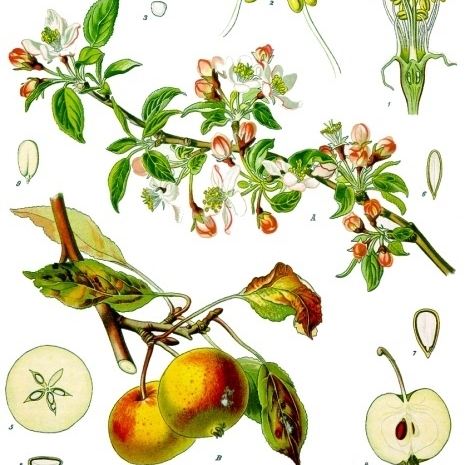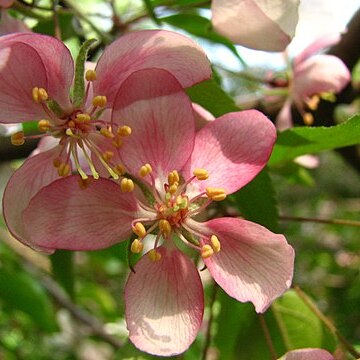Trees, 20–100(–150) dm. Stems 5–30 cm diam.; bark dark gray or gray-brown, scaly; young branches dark brown or reddish brown, densely tomentose, becoming glabrous; flowering shoots becoming spurs, 40–150 mm. Buds dark red or purple, ovoid, 3–4(–5) mm, scale margins densely puberulous. Leaves convolute in bud; isomorphic; stipules deciduous, lanceolate, 3–5 mm, apex acuminate; petiole 10–35 mm, tomentose to sparsely pubescent; blade elliptic, ovate, or broadly elliptic, (2–)5–10 × (1–)3–6.5 cm, base broadly cuneate or rounded, margins unlobed, obtusely serrate, sometimes serrate-crenate, apex acute, abaxial surface glabrescent, adaxial densely puberulent. Panicles umbel-like; peduncles absent; bracteoles deciduous, filiform, 5–7 mm. Pedicels 10–25 mm, puberulous. Flowers 30–40 mm diam.; hypanthium tomentose; sepals ?reflexed at flowering?, triangular-lanceolate or triangular-ovate, 6–8 mm, equal to or longer than tube, apex acuminate, surfaces tomentose; petals (rose in bud) white, sometimes pink, obovate, 15–25 mm, claws 1 mm, margins entire, apex rounded; stamens 20, 9–10 mm, anthers yellow before dehiscence; styles 5, basally connate less than 1/2 length, 9–10 mm, slightly longer than stamens, basally gray-tomentose; ?stigmas green?. Pomes green, yellow, or red, ?pure, striped, or blushed?, globose or depressed-globose, 20–50(–70) mm diam., ?skin with bloom or wax, sometimes russetted or dotted?, cores enclosed at apex; sepals persistent, erect; sclereids absent. Seeds light brown. 2n = 34 (51, 68).
More
Trees to 15 m tall. Branchlets purplish brown when old, terete, robust, short, densely tomentose when young, glabrous when old; buds purplish brown, ovoid, densely puberulous. Stipules caducous, lanceolate, 3–5 mm, herbaceous, densely puberulous, margin entire, apex acuminate; petiole robust, 1.5–3 cm, puberulous; leaf blade elliptic, ovate, or broadly elliptic, 4.5–10 × 3–5.5 cm, both surfaces densely puberulous when young, adaxially glabrescent, base broadly cuneate or rounded, margin obtusely serrate, apex acute. Corymb at apices of branchlets, 4–6 cm in diam., 3–7-flowered; bracts caducous, linear-lanceolate, membranous, tomentose, margin entire, apex acuminate. Pedicel 1–2.5 cm, tomentose. Flowers 3–4 cm in diam. Hypanthium tomentose abaxially. Sepals triangular-lanceolate or triangular-ovate, 6–8 mm, longer than hypanthium, both surfaces tomentose, margin entire, apex acuminate. Petals white, obovate, 1.5–1.8 cm, base shortly clawed, apex rounded. Stamens 20, unequal, ca. 1/2 as long as petals. Ovary 5-loculed, with 2 ovules per locule; styles 5, slightly longer than stamens, gray tomentose basally. Pome red or yellow, depressed-subglobose, ca. 2 cm in diam., impressed at base; fruiting pedicel short and thickened; sepals persistent. Fl. May, fr. Jul–Oct. 2n = 24*, 34*, 51*, 68.
A tree. It grows 5-15 m high. It has a short trunk and a rounded head. The buds are pink. The flowers are white with some pink. The fruit are 5 cm across.
Can be grown by cuttings or seedlings. Seeds needs stratification.


